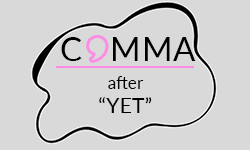
Many students struggle with the correct placement of commas, especially in academic writing. This difficulty often arises from a lack of thorough knowledge about the rules and exceptions governing comma usage. In this article, we focus on the intricate details of using commas after the word “yet.” We include examples and discuss the special cases involving commas with brackets. Additionally, we provide a practice sheet to help students assess their understanding of these concepts.
When to place a comma after “yet”
“Yet” functions as both an adverb and conjunction in the English language and is part of the seven coordinating conjunctions, also called FANBOYS. When considering the placement of a comma after the word “yet,” it’s essential to look at its role in the sentence. For instance, you only use a comma after “yet” when it is placed instead of “however,” “but,” or “despite that.” However, you do not use a comma after “yet” when it starts a sentence or acts as an adverb.
Comma
Alternative to “however,”
“but,” and
“despite that”
No comma
Beginning of a sentence
As an adverb
It’s important to note that the rules for using a comma after yet can vary depending on the style guide being followed, such as APA style, MLA, or Chicago style. Additionally, there may be exceptions and variations based on the context or the writer’s style. They should consult the relevant style guide or evaluate the situation to determine the proper use of commas after yet.
Comma after “yet”
The use of a comma after “yet” is quite specific and occurs when “yet” serves not just as a coordinating conjunction but more as a transitional adverb, similar in function to words like “however,” “but,” or “despite that.” This usage emphasizes a shift or contrast in the discourse, and the comma helps to highlight this shift.
By using “yet” in this way, with a comma following it, you effectively highlight a turn or opposition in your narrative, guiding the reader through your argument or story with a clear signal of contrast or exception. This stylistic choice enhances the readability and rhetorical impact of your writing.
No comma after yet
The assertion that a comma after “yet” is never used is based on typical grammatical structures where “yet” connects closely to the elements that follow it.
Beginning of a sentence
When starting a sentence, “yet” is used as a transition word to connect back to previously mentioned ideas or situations, creating a smooth transition into the new sentence. Adding a comma immediately after “yet” in such cases would disrupt this continuity and is therefore avoided.
As an adverb
When functioning as an adverb, “yet” indicates continuation or an ongoing state, typically at the end of a clause. The word “yet” is integral to the clause it modifies and directly affects the verb or adjective it relates to. Placing a comma immediately after “yet” would artificially separate it from its clause, potentially altering the intended meaning or creating awkward pauses where none are logically required.
Test yourself!
Practice sheet
The following sentences provide a chance to practice placing commas after the word “yet.” To verify your answers, consult the second tab labelled “answers.”
- The project was challenging yet incredibly rewarding.
- She studied all night yet she still felt unprepared for the exam.
- The cake was delicious yet too sweet for my taste.
- He tried his best yet he couldn’t solve the problem.
- The movie was long yet it kept the audience engaged.
- It was raining heavily yet we decided to go for a walk.
- The team played well yet they didn’t win the match.
- The new policy is strict yet necessary for safety.
- She was tired yet she continued working late into the night.
- The book was difficult to read yet it was quite enlightening.
- The project was challenging yet incredibly rewarding. (No comma)
- She studied all night, yet she still felt unprepared for the exam. (Comma)
- The cake was delicious yet too sweet for my taste. (No comma)
- He tried his best, yet he couldn’t solve the problem. (Comma)
- The movie was long, yet it kept the audience engaged. (Comma)
- It was raining heavily, yet we decided to go for a walk. (Comma)
- The team played well, yet they didn’t win the match. (Comma)
- The new policy is strict yet necessary for safety. (No comma)
- She was tired, yet she continued working late into the night. (Comma)
- The book was difficult to read, yet it was quite enlightening. (Comma)
- ✓ Free express delivery
- ✓ Individual embossing
- ✓ Selection of high-quality bindings
FAQs
A comma is usually placed before “yet” when it functions as a conjunction linking two independent clauses.
In Chicago style, as with most other styles, a comma is not typically placed after “yet” unless the subsequent phrase is an independent clause that stands alone.
“Yet” can function as a conjunction or an adverb. As a conjunction, it introduces a contrast or exception (“She was tired, yet she stayed awake.”). As an adverb, it indicates that something has not occurred up to the present time (“He hasn’t arrived yet.”).
When used in the middle of a sentence as a conjunction, “yet” often follows a comma and connects two contrasting ideas or adds surprising information (“It was a cheap car, yet surprisingly reliable.”). As an adverb, it’s used without a comma and modifies the verb (“She hasn’t called yet.”).
